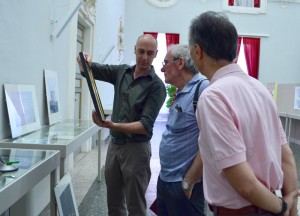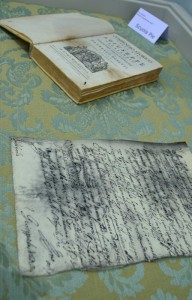A pharmacy professor who discovered the 19th century priest’s scientific papers now hopes to re-introduce Serpieri to the city he loved.
He was an educator, seismologist, astronomer, botanist, scholar of languages and a Catholic priest. In the 19th century, Padre Alessandro Serpieri was a well-known figure in Italy, and honored especially in Urbino, the ancient hill town where he ran the Collegio Raffaello – at that time a progressive school that provided free college-preparatory education for local youth.
Today, he is largely forgotten, even in Urbino, where university students walk under a bust of Serpieri when they pass from the town piazza into the Collegio courtyard.
But now, a professor of pharmacy is trying to bring Serpieri’s importance back to life.

Fancesco Mariani, exhibit volunteer, and Prof. Balsamini explain in detail the importance of Serpieri to the city of Urbino. Serpieri was a pioneer of free college and preparatory education.
Associate Professor Cesarino Balsamini, with help from colleagues, recently put together an exhibition of Serpieri’s journals, scientific notebooks and laboratory equipment in Urbino. The exhibition, filling two great halls on the second floor of the dignified 1741 Raffaello building, shut down June 24 after only three weeks of modest attendance.
Still, Balsamini’s admiration for Serpieri, and his plans for a Serpieri revival, continue to grow.
Serpieri’s story, as Balsamini arranged it through images and display cases that ran along all four walls of the grand Sala Raffaello, begins with Galileo. The famous Italian astronomer, Galileo, fell out with the Catholic Church two centuries before Serpieri was born. But a drawing of Galileo meeting with Joseph Calasanz, a Catholic priest in the early 17th century, begins the story. Calasanz started the religious order called the Scolopi Fathers, seeking to reconcile science and faith and also to provide free education for Italy’s poor. Two centuries later, this was also Alessandro Serpieri’s religious order, and his life’s work.
As the rector of the free school he named Raffaello, Father Serpieri made an impression on many school children. One of those students became one of Italy’s most popular poets, Giovanni Pascoli.
[pullquote]What gave him his power and strength was his religious motivation to teach his students.[/pullquote]
Era un genio. “He was a genius,” Balsamini said of Serpieri through a translator, “who anticipated many theories that were later discovered.”
“What gave him his power and strength was his religious motivation to teach his students.”
Due to Serpieri’s historical importance in the city of Urbino, Balsimani decided to research the scientist-priest. His investigation began in 2010 when the town celebrated 160 years of the establishment of the Serpieri Observatory. This observatory is still atop the 18th century building, a humble little part of Urbino’s skyline along with the famous Duomo and ducal palace. For that occasion, Balsamini said, he got hold of a goodbye letter which Serpieri wrote as he left Urbino to go to Florence. That letter also stated that he intended to continue his meteorological studies in Florence.
“Reading the letter, it was evident that [Serpieri] brought his registers with him to Florence, since he needed them to continue his work,” said Balsamini.
In the past, researchers had looked for these documents in Florence without success. Balsamini and his colleague extended the search to every place in Florence that had a link with Serpieri’s religious order, the Scolopi Fathers.
Two years ago, they came across a school at the center of Florence that is managed by the Scolopi, Scuole Pie Fiorentine, and through a friend of Balsamini they found over 15,000 documents signed by Serpieri.
Since the documents were found in the Scuole Pie Florentine, the University of Urbino could not permanently bring them back to the place where Serpieri started his research. And it would have cost the University over 50,000 euro ($62,500) to digitalize the documents in Florence. Since the funds were not available, Balsamini asked the director of the school in Florence if the University of Urbino could borrow the documents and digitalize them.

One out of 15,000 documents and archives found in Florence. Shortly after Serpieri moved to Florence from Urbino, he died leaving all his seismology and astronomy research papers in the Scuole Pie Fiorentine.
The documents were delivered in five boxes insured for 100,000 euro ($125,000), Balsamini said. The original deadline to return the documents was Oct. 10. However, Balsamini was given an extension until the end of the year, since scanning and photographing the documents is complicated.
The exhibition served two main purposes. One was to educate people about Alessandro Serpieri and the other was to digitize Serpieri’s missing manuscripts to keep a copy in Urbino.
“This exhibit should be a motivation too for the faculty to continue to research on Serpieri’s topics, such as biodiversity and seismology,” said Balsamini.
The exhibition’s organizers did not expect many people to attend. The team of three volunteers guided over 300 tours over the three-week period.
In preparation for opening, Balsamini spent the past two years learning and teaching himself about this scientist in order to tell a compelling story.
“This is a very important discovery for the city of Urbino,” said Francesco Mariani, an exhibit volunteer who has a Ph.D. in Art History. “Knowing your own history brings back identity to the people. Alessandro Serpieri was a huge education figure, and it’s great that Professor Balsamini devoted (so) much time to this educational exhibit.”
Balsamini received little financial support from the university for the exhibition. He said he received 1,000 euro from the university, 2,500 from outside sponsors and used 3,000 from his own research money ($8,125 total) to hold this exhibit.
It’s not uncommon currently in Italy that many museums and exhibitions are lacking money, said Balsamini.
“We are poor. It was a cheaply made exhibition but it had to be well executed,” he said.
One of the exhibit goers described the display as breathtaking and exciting.
“Serpieri was cutting edge and was a pioneer of science,” said Andrea Seraghiti, 30, a computer technician. “I hope this benefits a lot of people and attracts tourists to the city and becomes permanent.”
As the exhibition came to an end, Balsamini was already planning the second part of the project. It will be a second exhibition about Serpieri’s most famous student, Italian poet Giovanni Pascoli. Pascoli, who as a child lost his family’s wealth in the tragic death of both parents, was deeply influenced by Serpieri’s rigorous attention to the data of nature and its many elusive correlations.
Balsamini found beautiful lines of Pascoli’s poetry about the moon, clouds and flora that echoed, in another form, some of Serpieri’s scientific insights. The next exhibition, to take place this fall, will show these links between Serpieri’s science and Pascoli’s poetry.
The busts of both men, from 1925, face one another in the archway leading to the Collegio courtyard, still little noticed by passersby.
Multimedia